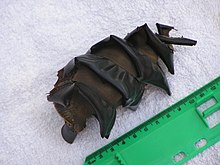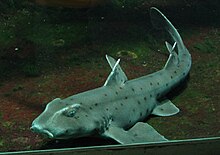Bullhead sharks
| Bullhead sharks | ||||||||||||
|---|---|---|---|---|---|---|---|---|---|---|---|---|

Crested bullhead shark ( Heterodontus galeatus ) |
||||||||||||
| Systematics | ||||||||||||
|
||||||||||||
| Scientific name of the order | ||||||||||||
| Heterodontiformes | ||||||||||||
| Berg , 1940 | ||||||||||||
| Scientific name of the family | ||||||||||||
| Heterodontidae | ||||||||||||
| Gray , 1851 | ||||||||||||
| Scientific name of the genus | ||||||||||||
| Heterodontus | ||||||||||||
| Blainville , 1816 |
The bull head sharks ( Heterodontus ), horn sharks or great dane sharks are the only recent genus of the monotypical family of the Heterodontidae, which in turn alone forms the order of the bull head sharks (Heterodontiformes). They are found in the warm, temperate and tropical seas from the western Indian Ocean to the eastern Pacific . In Atlantic bullhead shark are not represented.
features
They owe their German name to their head, which is atypical for sharks, with clear bulges and a rounded snout. You don't have a nose whiskers . Your eyes have no nictitating membrane and are on the sides of the top of your head (dorsolateral).

The mouth is medium-sized, with small multi-pointed molars at the front and flattened molars at the rear. The Greek generic name ( heterodontus - "different types of teeth") refers to it. The outer nostrils are small and connected to the mouth by a deep fold. They also have five gill slits , the first of which is enlarged and furthest down. Two or three gill slits lie behind the base of the pectoral fins .
Common to all bullhead sharks is the presence of anal fins and two dorsal fins ( fins) , each preceded by a thorn. They differ from all other galeomorphic sharks in the presence of the dorsal fin spines . An anal fin is present. Their trunk is cylindrical or slightly flattened on the sides. Bullhead sharks have 98 to 123 vertebrae.
Bullhead sharks are smaller than other species of shark. The largest species, the Port Jackson bullhead shark ( Heterodontus portusjacksoni ) or horn shark, is only 165 centimeters long. One of the English names for the Heterodontidae family Port Jackson sharks is derived from this species of shark that was first described .
Bullhead sharks lay eggs . The egg capsules are helical.
Way of life
Bullhead sharks are sluggish bottom fish that feed primarily on mussels , sea urchins, and other hard-shelled animals. They can walk across the bottom on their pair of fins and only swim occasionally. Their habitat is on the continental shelf and shelf areas belonging to islands at depths of up to 275, mostly less than 100 meters. They bite down when harassed by divers.
species
Nine recent species are described.
- Horn shark ( Heterodontus francisci ( Girard , 1855) )
- Combed bullhead shark ( Heterodontus galeatus ( Günther , 1870) )
- Japanese bullhead shark ( Heterodontus japonicus Maclay & Macleay , 1884 )
- Mexican bullhead shark ( Heterodontus mexicanus Taylor & Castro-Aguirre , 1972 )
- Heterodontus omanensis Baldwin, 2005
- Port Jackson bullhead shark ( Heterodontus portusjacksoni ( Meyer , 1793) )
- Galapagos bullhead shark ( Heterodontus quoyi ( Fréminville , 1840) )
- White-spotted bullhead shark ( Heterodontus ramalheira ( Smith , 1949) )
- Zebra bullhead shark ( Heterodontus zebra ( Gray , 1831) )
Tribal history
The genus Heterodontus is fossilized from the Upper Jurassic . In addition to Heterodontus , the Upper Jurassic genus Paracestracion is also included in the Heterodontidae family.
Individual evidence
- ^ Karl Albert Frickhinger: Fossil Atlas of Fishes. Mergus-Verlag, Melle, 1999, ISBN 3-88244-018-X .
literature
- Joseph S. Nelson : Fishes of the World: John Wiley & Sons, 2006, ISBN 0-471-25031-7 .
- Kurt Fiedler: Textbook of Special Zoology. Volume 2, Part 2: Fish. Gustav Fischer Verlag, Jena 1991, ISBN 3-334-00339-6 .
Web links
- Heterodontus on Fishbase.org (English)
- Heterodontidae on Fishbase.org (English)
- Heterodontiformes on Fishbase.org (English)


